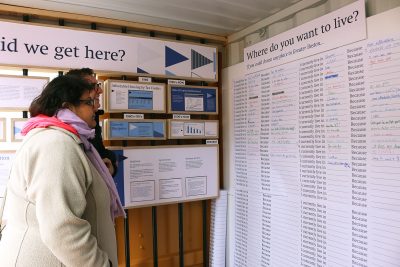
Large domes rose out of City Hall Center last week as people thronged for the silent discos, keynote speeches and art exhibitions of HUBweek.
The annual creative festival based in Boston explored future possibilities and causes of collaboration with more than 300 artists, entrepreneurs, scientists and organizations across the globe.
The conference, which was created in 2014, was hosted by The Boston Globe, Harvard University, Massachusetts Institute of Technology and Massachusetts General Hospital. The theme of the festival was “We the Future,” featuring interactive experiences like speaker panels, art and tech exhibitions, startup showcases, drone demonstrations and pitch competitions.
Focusing on the startup experience and resources, nine Demo Day sessions were held Saturday and included founder talks, a gathering of more than 100 startups and a pitch competition.
Food For All, a startup venue giving deals on unsold restaurants meals, was the final winner. In the pitching presentation, David Rodríguez, CEO and one of the co-founders of the startup, said the initiative was created to aid in the astounding number of food wastes in the United States and was partially inspired by his own experience as an international student living on a limited meal budget.
Food For All offers meals for as little as $3.
Pilleve, Ompractice, Aisling Organic Cosmetics, Lumme, Inc. and Waku were all runners-up to the final prize. From designing pill bottles preventing prescription medicine overdose to making a wellness tea from the Andes Mountains in Ecuador, the six finalists’ companies focused on creating products or offering services to build a more friendly social and eco environment.

Panel talks like “Build in Boston. Stay in Boston.” were held in the Demo Day sessions, emphasizing the significance of the talent pool and academic resources Boston has to offer to entrepreneurs.
Impact-oriented artists like Sarah Slifer Swift said her and her dance company Meek Productions performed several pieces concerning the environmental issues, such as “Species, Wall and Glacier.”
In the Glacier piece, she said she and two other dancers hugged and fell slowly to the ground. Their colleague, dressed in a glittering white robe resembling a glacier, walked around asking bystanders what actions could be taken.
They performed the piece several times with minor variations, representing different stages of the melting.
“We want something that digs in a little severity of the situation,” Swift said, “so something that’s a little disturbing in the end.”
According to Swift, they started only showing the melting, not giving people instructions. They then let everyone brainstorm the things they know that could help so they could intervene with the melting physically.
Aaron Ye, a first-year BU graduate student studying journalism, actively participated with his friends, trying to recreate the glacier dancers.
“It’s stressful,” Ye said.
However hard they tried to reconstruct the dancers or use the duct tape to bind them together, the dancers fall onto the ground eventually, Ye said.
Ye and his friends also participated in HUBweek’s silent discos, which happened Tuesday and each night from Thursday to Saturday. Three DJs were invited to each disco and took charge of one channel on the headsets. People who came to the disco danced to music playing in headphones rather than speakers.
“I’m interested to see how it catches on,” Danny Mckenzie, 40, from Boston, said. “I don’t see it as mainstream, but a novelty. People are enjoying the new experience of the absurdity of bonding together with their headphones on.”
Each headphone could turn into three different colors, and each shade represented the channels the DJs used. Ye said he and his friends danced to different channels at points and enjoyed themselves.
He explained he felt more college parties should be designed like silent discos.
“I would say it’s more a spiritual connection than a physical one,” Ye said.
“We the Future: A Public Art Exhibition” was installed for the span of HUBweek and featured shipping containers as a piece that reflected the housing crisis and other major issues in the city.
The exhibition also included a participatory multimedia installation called “We the Publics.” The installation explored topics such as the role of power and the public’s role in establishing an environment.
“We the Publics” was originally created by Dan Borelli, director of exhibitions in Harvard University’s Graduate School of Design, and Emmanuel Pratt, executive director of Sweet Water Foundation.
In the spirit of the exhibition centered around “publics” and groups of people, Borelli emphasized the importance of cooperation and the overarching message of the piece.
“I think [attendees] walk away with a greater sense of responsibility to the whole, to each other,” Borelli said. “[It’s] public possibility.”
















































































































